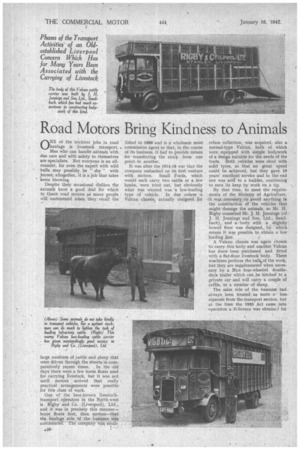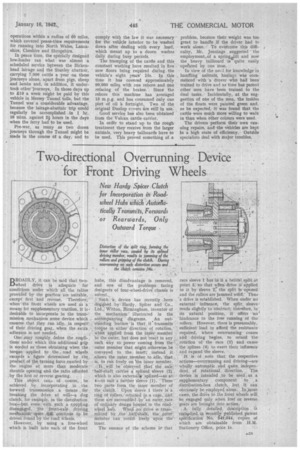Road Motors Bring Kindness to Animals
Page 32

Page 35

If you've noticed an error in this article please click here to report it so we can fix it.
ONE of the trickiest jobs in road {1/4/haulage is livestock transport. 4 Mon who can handle animals with .due care and with safety to themselves
n
are specialists. Not everyone is a allrounder, for even the expert with wild bulls may possibly be " shy " with horses; altogether, it is a job that takes some knowing. Despite their occasional dislikes the animals have a good deal for which to thank road motors as many people • will understand when they recall the large numbers of cattle and sheep that were driven thrthih the streets in com paratively recent times. In the old days there were a few horse floats used for carrying livestock, but it Was not until motors " -arrived that really • practical arrangements were possible
for this class of work. •
One of the best-known livestocktransport operators in the North-west is Rigby and Co. (Liverpool), Ltd., and it was in precisely this manner— horse floats first, then motors—that the haulage. side of the buSiness was commenced.'The conifiliy \va esia13
A3O
lished irr 1886 and is a wholesale meat commission agent so that, in the course of its business, it had to provide means Jar 'transferring the stock from one point, to another. It was after the 1914-18 war that the company embarked on its first venture with motors. Small Fords, which would each carry two cattle or a few lambs, were tried out, but obviously what was wanted was a low-loading type of vehicle. In due course -a Vulcan chassis, actually designed for refuse collection, was acquired, also a normal-type Vulean, both of which were equipped With simple bodywork of a design suitable for the needs of the trade. Both vehicles were shod with solid tyres, so that no great speed could be achieved, but they gave 19 years' excellent service and in the end one was soli{ to a builder, continuing to earn its keep by work on a tip. By that time, to meet the requirements of the Ministry of Agriculture, -it was necessary to avoid anything is the construction of the vehicles that might -damage the animals, so Mr. H. Rigby consulted Mr. J. H. Jennings (of J. H. Jennings and Son, Ltd., Sand_ bach), and a 'body with a slightly bowed floor was designed, by which means it was possible to obtain a low loading line.
A Vulcan chassis was again chosen to carry this body and another Vulcan has since been purchased and fitted with a flat-floor livestock body. These machines perform the bulk,of the WOIt, but they are supplemented when necessary bya Rice four-wheeled doubledeck trailer which can be hitched to a private car and will carry a couple of cattle, or a number of sheep.
. The sales side of the business had. always been treated as more o. lessseparate from the transport section. but at the time the 1933 Act came ,into -operation a 'B-licence was obtained for operations Within a radius of 60 miles, which covered peace-time requirements for running into North Wales, Lancashire, Cheshire and Shropshire.
In peace time, the specially designed low-loader ran what was almost a scheduled service between the Birkenhead lairage and the Stanley abattoir, carrying 7,000 cattle a year on these journeys alone, apart from pigs, sheep and lambs and, in addition, it undertook other journeys. In those days up to £10 a week might be paid by this vehicle in Mersey Tunnel tolls, but the Tunnel was a considerable advantage, because the lairage-abattoir trip could regularly be accomplished in 1 hr. 10 mins. against 2* hours in the days when the ferry had to be used.
Pre-war, as many as two dozen journeys through the Tunnel might be . made in the course Of a day, and to comply with the law it was necessary for the vehicle interior to be washed down after dealing with every load, which meant up to a dozen washes daily during busy periods.
The tramping of the cattle and this constant washing have resulted in five new floors being required during. the vehicle's eight years' life. In this time it has covered approximately 90,000 miles with one rebore and one refacing of the brakes. Since the rebore this machine has averaged 13 m.p.g. and has consumed only one pint of oil 'a fortnight. Two of the original Dunlop covers are still in use
Good service has also been obtained from the Vulcan cattle carrier.
In order to stand up to the rough treatment they receive from the larger animals, very heavy tailboards have to be used. This proved something of a
problem, because their weight was too great to handle if the driver had to work alone. To overcome this difficulty, Mr. Jennings suggested the employment of a springelift and now the heavy tailboard is quite easily ope?ated by one min.
In view of the necl for knowledge in handling animals, haulage was commenced with "a drover whit) had been trained to drive and as time has passed other men have been trained to the dual tasks. Incidentally, at the suggestion of one of the men, the insides of the floats were painted green and. as he expected, it was found that the cattle were mtich more willing to walk in than when other colours were used.
The drivers perform their own running repairs. and the vehicles are kept In a high state of efficiency. Outside specialists deal with major troubles.




















































